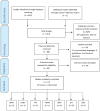Breast milk transmission of flaviviruses in the context of Zika virus: A systematic review
- PMID: 29882971
- PMCID: PMC6103797
- DOI: 10.1111/ppe.12478
Breast milk transmission of flaviviruses in the context of Zika virus: A systematic review
Abstract
Background: Since the Zika virus epidemic in the Americas began in 2015, Zika virus transmission has occurred throughout the Americas. However, limited information exists regarding possible risks of transmission of Zika virus and other flaviviruses through breast feeding and human milk. We conducted a systematic review of the evidence regarding flaviviruses detection in and transmission through milk, specifically regarding Zika virus, Japanese encephalitis virus, tick-borne encephalitis virus, Powassan virus, West Nile virus, dengue virus, and yellow fever virus.
Methods: Medline, Embase, Global Health, CINAHL, Cochrane Library, Scopus, Popline, Virtual Health Library, and WorldCat were searched through June 2017. Two authors independently screened potential studies for inclusion and extracted data. Human and nonhuman (animal) studies describing: 1) confirmed or suspected cases of mother-to-child transmission through milk; or 2) the presence of flavivirus genomic material in milk.
Results: Seventeen studies were included, four animal models and thirteen observational studies. Dengue virus, West Nile virus, and Zika virus viral ribonucleic acid was detected in human milk, including infectious Zika virus and dengue virus viral particles. Human breast-feeding transmission was confirmed for only yellow fever virus. There was evidence of milk-related transmission of dengue virus, Powassan virus, and West Nile virus in animal studies.
Conclusions: Because the health advantages of breast feeding are considered greater than the potential risk of transmission, the World Health Organization recommends that mothers with possible or confirmed Zika virus infection or exposure continue to breast feed. This review did not identify any data that might alter this recommendation.
Keywords: Zika virus; breast feeding transmission; breast milk; flavivirus.
Published 2018. This article is a U.S. Government work and is in the public domain in the USA.
Conflict of interest statement
Figures
References
Publication types
MeSH terms
Grants and funding
LinkOut - more resources
Full Text Sources
Other Literature Sources
Medical


